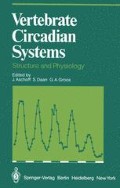Abstract
To be of full functional significance for the organism, circadian rhythms have to be synchronized to the 24-h day. This is done by response to periodic signals from the environment, the Zeitgebers (Pittendrigh 1981). The entrained state is characterized by a stable phase angle difference ψ between rhythm and Zeitgeber; sign and amount of ψ depend on the period τ of the rhythm (as measured in constant conditions) and on the period T of the Zeitgeber. Furthermore, circadian systems can be entrained to periods deviating from 24 h only within certain limits (Aschoff and Pohl 1978).
Access this chapter
Tax calculation will be finalised at checkout
Purchases are for personal use only
Preview
Unable to display preview. Download preview PDF.
References
Albers HE, Lydie R, Moore-Ede MC (1980) Light-dark cycle entrainment of the persisting circadian rhythm of core body temperature on SCN-lesioned primates. Neurosci Abstr 6:708
Aschoff J (1978) Features of circadian rhythms relevant for the design of shift schedules. Ergonomics 21:739–754
Aschoff J (1981) Circadian rhythms: interference with an dependence on work-rest schedules. In: Johnson LC, Tepas DI, Colquhoun W P, Colligan MJ (eds) Biological rhythms and shift work. Advances in sleep research, vol VII. Spectrum Publ, New York
Aschoff J, Pohl H (1978) Phase relations between a circadian rhythm and its Zeitgeber within the range of entrainment. Naturwissenschaften 65:80–84
Aschoff J, Saint Paul U von (1976) Brain temperature in the unanaesthetized chicken: its circadian rhythm of responsiveness to light. Brain Res 101:1–9
Boulos Z, Rosenwasser AM, Terman M (1980) Feeding schedules and the circadian organization of behavior in the rat Bëhav. Brain Res 1:39–65
Bovet J, Oertli EF (1974) Freerunning circadian activity rhythms infreeliving beaver (Castor canadensis). J Comp Physiol 92:1–10
Davis FS, Menaker M (1980) Hamsters through time’s window: temporal structure of hamster locomotor rhythmicity. Am J Physiol 239: R149–R155
DeCoursey P (1960) Phase control of activity in a rodent. Cold Spring Harbor Symp Quant Biol 25:49–54
Enright JT (1965) Synchronization and ranges of entrainment. In: Aschoff J (ed) Circadian Clocks. North Holland Publ Comp, Amsterdam pp 112–124
Gaston S, Menaker M (1968) Pineal function: The biological clock in the sparrow? Sciense 160: 1125–1127
Gibbs FP (1979) Fixed interval feeding does not entrain the circadian pacemaker in blind rate. Am J Physiol 236:R249–253
Gwinner E (1966) Entrainment of a circadian rhythm in birds by species-specific song cycles (Aves, Fringillidae: Carduelis spinus, Serinus serinus). Experientia 22:765
Gwinner E (1978) Effects of pinealectomy on circadian locomotor activity rhythms in European starlings, Sturnus vulgaris. J Comp Physiol 126:123–129
Hayden P, Lindberg RG (1969) Circadian rhythm in mammalian body temperature entrained by cyclic pressure changes. Science 164:1288–1289
Hoffmann K (1969a) Zum Einfluß der Zeitgeberstärke auf die Phasenlage der synchronisierten circadianen Periodik. Z Vergl Physiol 62:93–110
Hoffmann K (1969b) Die relative Wirksamkeit von Zeitgebern. Oecologia 3:184–206
Honma KI, Aschoff J (1981) Effects of periodic feeding on circadian rhythms in the rat (in prep.)
Kato H, Saito M, Suda M (1980) Effect of starvation on the circadian adrenocortical rhythm in rats. Endocrinology 106:918–921
Krieger DT, Hauser H (1978) Comparison of synchronization of circadian corticosteroid rhythms by photoperiod and food. Proc Natl Acad Sci 75:1577–1581
Krieger D, Hauser H, Krey LC (1977) Suprachiasmatic nuclear lesions do not abolish food-shifted circadian adrenal and temperature rhythmicity. Science 197:398–399
Marimuthu G, Rajan S, Chandrashekaran MK (1981) Social entrainment of the circadian rhythm in the flight activity of the microchiropteran bat, Hipposideros speoris. Behav Ecol Sociol 8:147–150
Philippens KMH, Mayersbach H von, Scheving LE (1977) Effects of the scheduling of meal feeding at different phases of the circadian system in rats. J Nutr 107:176–193
Pittendrigh CS (1981) Circadian systems: entrainment. In: Aschoff J (ed) Biological Rhythms. Handbook of Behavioral Neurobiology, vol IV. Plenum Press, New York, pp 95–124
Richter CP (1968) Inherent twenty-four hour and lunar clocks of a primate — the squirrel monkey. Comm Behav Biol Part A 1:305–332
Schwartz WJ, Smith CB, Davidsen LC (1979) In vivo glucose utilization of the suprachiasmatic nucleus. In: Suda M, Hayaishi O, Nakagawa H (eds) Biological Rhythms and their Central Mechanism. Elsevier/North Holland Biomedical Press, Amsterdam, pp 355–367
Stephan FK (1981) Limits of entrainment to periodic feeding in rats with suprachiasmatic lesions. J Comp Physiol A 143:401–410
Suda M, Saito M (1979) Coordinative regulation of feeding behavior and metabolism by a circadian timing system. In: Suda M, Hayaishi O, Nakagawa (eds) Biological Rhythms and their Central Mechanism. Elsevier/North-Holland Biomedical Press, Amsterdam, pp 263–271
Sulzman FM, Fuller ChA, Moore-Ede MC (1977) Feeding time synchronizes primate circadian rhythms. Physiol Behav 18:775–779
Sulzman FM, Fuller ChA, Hiles G, Moore-Ede MC (1978a) Circadian rhythm dissociation in an environment with confliciting temporal information. Am J Physiol 235:R175-R180
Sulzman FM, Fuller ChA, Moore-Ede MC (1978b) Comparison of synchronization of primate circadian rhythms by light and food. Am J Physiol 234:R130-R135
Takahashi JS, Menaker M (1979) Brain mechanisms in avian circadian systems. In: Suda M, Hayaishi O, Nakagawa H (eds) Biological Rhythms and their Central Mechanism. Elsevier/North-Holland Biomedical Press, Amsterdam, pp 95–109
Tokura H, Aschoff J (1981) Entrainment of circadian activity rhythms by temperature cycles in primates (in prep)
Wever R (1979) The circadian system of man. Springer, Berlin Heidelberg New York
Wever R (1980) Circadian rhythms of finches under bright light: is self-sustainment a precondition for circadian rhythmicity? J Comp Physiol 139:49–58
Author information
Authors and Affiliations
Editor information
Editors and Affiliations
Rights and permissions
Copyright information
© 1982 Springer-Verlag Berlin · Heidelberg
About this paper
Cite this paper
Aschoff, J., Daan, S., Honma, KI. (1982). Zeitgebers, Entrainment, and Masking: Some Unsettled Questions. In: Aschoff, J., Daan, S., Groos, G.A. (eds) Vertebrate Circadian Systems. Proceedings in Life Sciences. Springer, Berlin, Heidelberg. https://doi.org/10.1007/978-3-642-68651-1_2
Download citation
DOI: https://doi.org/10.1007/978-3-642-68651-1_2
Publisher Name: Springer, Berlin, Heidelberg
Print ISBN: 978-3-642-68653-5
Online ISBN: 978-3-642-68651-1
eBook Packages: Springer Book Archive

